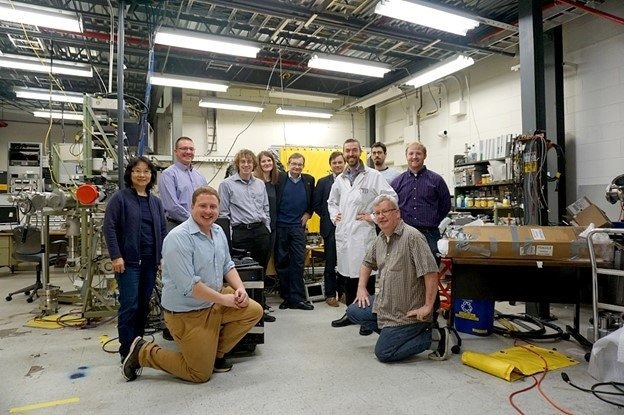May 6 2024Reviewed by Lexie Corner
Researchers from KDK Collaboration at the Holifield Radioactive Ion Beam Facility of Oak Ridge National Laboratory recently made the first direct observations of rare decay processes, such as K-40 decaying into Calcium-40 and into Argon-40 through electron capture. This provides insights into nuclear structure, potentially leading to improved accuracy in geological dating and a deeper understanding of nuclear physics. The study was published in Physical Review Letters.
 The Potassium Decay (KDK) Collaboration used the KDK array to detect a previously unmeasured process in the radioactive decay of potassium-40 to argon-40 involving a rare type of electron capture. Image Credit: KDK Collaboration
The Potassium Decay (KDK) Collaboration used the KDK array to detect a previously unmeasured process in the radioactive decay of potassium-40 to argon-40 involving a rare type of electron capture. Image Credit: KDK Collaboration
Certain elemental nuclei undergo radioactive decay to become nuclei of other elements. These decays, depending on the situation, can be helpful or annoying. This particularly applies to potassium-40. Typically, this isotope decays to calcium-40, but it also decays to argon-40 around 10 % of the time. This decay path includes an electron capture process that reveals details about the nuclear structure. Since potassium-40 has an extremely long half-life, it can also be used to determine the age of geological objects on billion-year time scales.
Discovering new pathways for potassium-40’s decay is difficult because of its lengthy half-life. The first direct observations of a very rare but crucial potassium-40 to argon-40 decay path have now been made during a month-long campaign. The outcome might raise precision and enhance scientists’ comprehension of physical processes.
The Impact
The majority of potassium-40 electron capture decays result in an excited form of argon-40. The rare, theoretically calculated electron capture decay that instead results in the potassium-40 ground state was measured by the Potassium Decay (KDK) Collaboration. There is a broad range of predictions from the theoretical calculations. This range restricts the application of potassium-40 to the solar system and geological feature ages.
The team’s experimental result lowers this range. The outcome also enhances the estimates of potassium properties scientists require for specific physics experiments. Ultimately, the outcome implies that the rates of neutrinoless double-beta decay for light element nuclei are lower than anticipated.
Summary
More stable isotopes are produced when radioactive nuclei decay via one or more modes. Using the KDK array (K = Potassium DK = Decay), the KDK Collaboration measured a rare decay branch of potassium-40 at the Holifield Radioactive Ion Beam Facility of Oak Ridge National Laboratory (ORNL). The Modular Total Absorption Spectrometer at ORNL is combined with a silicon drift X-Ray detector created specifically for the KDK array.
Quantifying the decay rates of potassium-40 and its decay branches is challenging. This is because measurements of the parent nucleus and a significant number of rare offspring are required. About 10 % of all potassium-40 decays result in argon-40, the subset of potassium-40 that the KDK Collaboration studied.
A tiny fraction of potassium-40 electron-capture decays occur without producing any gamma rays, even though the majority of these decays produce a distinctive gamma ray that serves as a background in most experiments.
This is the result of an electron going straight to the ground state of argon-40 being captured by potassium-40. The decay was first directly measured by the KDK Collaboration. The accomplishment suggests that other decay rates might also require reevaluation.
The KDK Collaboration has detected and measured a rare decay branch that affects nuclear structure predictions, offers unique experimental evidence of so-called forbidden beta decays, and eliminates a long-standing uncertainty for geological and solar system age estimates based on potassium. The results also enhance the evaluation of the background typically encountered in experiments looking for physics beyond the Standard Model.
Funding
This study was funded by the Department of Homeland Security, Queen’s University of Canada, the MacDonald Institute, the Natural Sciences and Engineering Research Council of Canada, the Department of Energy Office of Science, and the Nuclear Physics program.
Journal References:
Stukel, M., et al. (2024) Rare K 40 Decay with Implications for Fundamental Physics and Geochronology. Physical Review Letters. doi.org/10.1103/physrevlett.131.052503
Hariasz, L., et al. (2024) Evidence for ground-state electron capture of 40 K. Physical Review Letters. doi.org/10.1103/PhysRevC.108.014327.
Source: https://www.energy.gov/